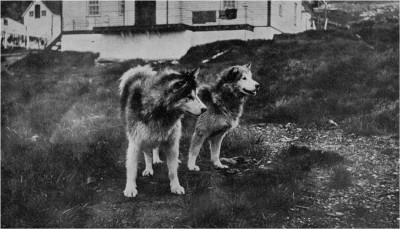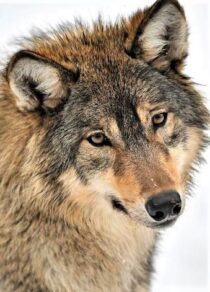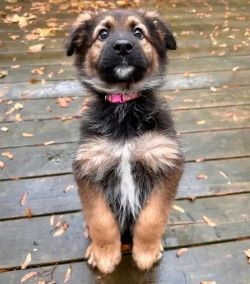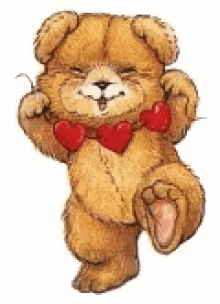Dog Intelligence List…
DOG INTELLIGENCE: The Top 10 Most Intelligent Dog Breeds. Is Yours On the Most Intelligent Dogs List?
1. “Left for the wolves.”
In the early spring of 1902, Constable Richard Morris, of the North-West Mounted Police, reported an incident dealing with the native Cree Indians and their dogs.

Posted to a community north of Lake Winnipeg, he noticed that a number of husky dogs had been staked out in the forest. Each one was left alone and fastened to an iron stake by a chain. When he asked the reason for this, the Crees told him that the dogs were “left for the wolves.”
When Constable Morris objected to this treatment, the Crees explained that the dogs wouldn’t be harmed by the wolves. The dogs — Ungava huskies — were bitches in heat. Male wolves without mates of their own would be attracted to the bitches and mate with them, resulting in cross-bred puppies with “wolfblood” — a husky mix.
Constable Morris said, “Oh, I see. This is so your sled-dogs will be bigger and stronger.”
“No,” replied one Cree. “A wolf can outrace our dogs in a quick dash. But our huskies, they have much more stamina than wolves and can easily outlast them in a long run. Wolves make poor work dogs.”
“Then,” concluded Morris, “it’s because wolves are healthier.”
“No. They are the same.”
“Then why?” asked the Mountie.
“Up here,” replied the Indian, tapping his own forehead.
Father LeBeaux, an Oblate Missionary, later explained, “The Cree people believe that when an animal becomes domesticated, each generation loses in intelligence. That’s why wolves are more intelligent than dogs. The Indians say, ‘The closer to the wolf, the smarter the dog.’ If this is true of domesticated animals, what does that say of civilized Man, eh?”
2. “How intelligent are they?” Most & Least…
Our ancestors might have asked this 30,000 years ago when they played with their wolf dogs. [1]
Even the ancient Egyptians asked that Dog Intelligence question, and studied their own dogs to answer it.
One of the first modern attempts was by Rene Descartes, who only went one step beyond the cloudy thinking of his time, saying all animals were just soulless biological machines. Descartes set up the narrow, human-centered theory of behaviorism that would dominate until well into the 20th Century.
For decades, behaviorists put animals — including dogs — through sterile tests in sterile labs, looking for mechanical dog intelligence results that proved worthless.
In the middle of this muddle came one sane voice: Donald Griffin, professor of biology at Rockefeller University, who said, “Behaviorism should be abandoned not so much because it belittles the value of living animals, but because it leads to a serious incomplete and hence misleading picture of reality.”
In 1953, Konrad Lorenz’s book MAN MEETS DOG created an instant classic about dog intelligence.
Written with humor, wisdom and great insight, the German Nobel Laureate almost single-handedly recreated our methods of exploring animal behavior.
In his ground-breaking 1994 book THE INTELLIGENCE OF DOGS — CANINE CONSCIOUSNESS AND CAPABILITIES, Canadian Stanley Coren, psychologist, dog trainer, and “avowed dog lover,” presented his controversial Ranking of Dogs for Obedience and Working Intelligence.
Coren ranked 133 breeds, from #1 on for dog intelligence… The reaction was predictable: “The Poodle? He ranked a POODLE above my Belgian sheepdog?” “Come on! My Samoyed is smarter than any Australian Cattle Dog!” “No Papillon can out-think my Lassie.” “OK, maybe a Poodle is intelligent — but…” “Coren’s saying that my Afghan Hound is the least intelligent dog breed? Wrong!”
“Controversial” doesn’t begin to describe the reaction to “Coren’s Ranking.”
But his observations have proven to be pretty accurate.
Of course, Coren was testing pure breeds.
 There are very few original Ungava huskies still around. And the “purebred” Siberian husky, for instance, isn’t as quick-witted as the native husky of northern Siberia. This is even more true of the Alaskan malamute. Modern Canadian huskies have been so interbred with smaller racing breeds, that they hardly resemble the huge savage animals that European explorers met a few centuries ago. We deliberately breed out some of the “wolfishness” in our pets. And therefore dog intelligence. [2]
There are very few original Ungava huskies still around. And the “purebred” Siberian husky, for instance, isn’t as quick-witted as the native husky of northern Siberia. This is even more true of the Alaskan malamute. Modern Canadian huskies have been so interbred with smaller racing breeds, that they hardly resemble the huge savage animals that European explorers met a few centuries ago. We deliberately breed out some of the “wolfishness” in our pets. And therefore dog intelligence. [2]
The great American author and Northern explorer George Marsh wrote about Ungava Huskies in such books as his classic FLASH THE LEAD DOG. See my Wolf Whelps & Lead Dogs: Tribute to George Marsh, Wilderness Writer.
3. “Never Cry Wolf!”
In 1963, Farley Mowat’s NEVER CRY WOLF appeared on the bookshelves. Described as “an intimate casebook in wolf sociology,” Mowat told how, as a biologist employed by the Canadian Wildlife Service, he had spent a summer on his own, studying a pack of Arctic wolves. The book sparked an avid interest in wolf research that has never dimmed.
IN PRAISE OF WOLVES and SECRET GO THE WOLVES recounted R D Lawrence’s close experiences with wolves in Canada. DANCE OF THE WOLVES by Roger Peters describes his three winters in the forests of northern Michigan. These and others have shown us the remarkable lives and intelligence of the wolf.
R D Lawrence wrote: “Reality, particularly in the case of wolves, means that these animals have keen intelligence, excellent memory, and demonstrable capacity of conscious thought.”
He went on to explain, “When Shawano fed his pack before keeping a piece of chicken for himself, he demonstrated not only that he could profit from experience in a profitable way, but that other wolves could do so as well.
“This demonstration is alone sufficient to discredit the mechanistic theory which contends that evolution, by means of hereditary imprinting, has led to the thoughtless or automatic responses of animals to any one of an enormously wide variety of natural stimuli…
“Memory, by allowing an animal to benefit from experience, plays an important role in the formulation of conscious decisions; the better its memory, the better able will the animal be to adapt to a changing environment.”
It’s the wolf’s intelligence, as well as its loyalty and great heart that caused our ancient ancestors to bring the wolf into their families. And perhaps its organized hunting skills.
Today, some of us still mingle with wolves, in sanctuary and in the wild.
“THE TOP TEN MOST INTELLIGENT DOGS!”
What, then, are the smartest breeds?
Who wins the Dog Intelligence Test?
Taking in the conclusions of dog trainers, psychologists and researchers, as well as those who work with dogs in life and death situations, such as police, search & rescuers, and wilderness inhabitants — and balancing the Cree wisdom: “the closer to the wolf, the smarter the dog!” [3] with ongoing research into the long evolution of dogs, here are the TEN MOST INTELLIGENT DOGS:
1. Ungava Husky, or Wolf Dog
2. German Shepherd
3. Golden Retriever
4. Labrador Retriever
5. Border Collie
6. Poodle
7. Doberman Pinscher
8. Papillon
9. Nova Scotia Duck Tolling Retriever
10. Alaskan Malamute
If your dog is not on this list, you can be sure it’s #11!
Live Free, Mon Ami! – Brian Alan Burhoe
Do you love wild animal tales?
 IF SO, YOU MIGHT WANT TO READ WOLFBLOOD — MY MOST POPULAR ANIMAL YARN: “I LOVE THE HAPPY ENDING!”
IF SO, YOU MIGHT WANT TO READ WOLFBLOOD — MY MOST POPULAR ANIMAL YARN: “I LOVE THE HAPPY ENDING!”
“I JUST READ WOLFBLOOD AGAIN FOR GOOD MEASURE. ONE FOR ANY WOLF LOVER. ENJOYED IT BUT WISH IT WAS A FULL LENGTH NOVEL.” – Gina Chronowicz @ginachron
“GREAT SHORT STORY! DOES REMIND ME OF CALL OF THE WILD, WHITE FANG…” – Evelyn @evelyn_m_k
An “entertaining and affectionate” narrative in the Jack London Tradition of a lone Gray Wolf and his quest for a place in the far-flung forests of the feral North. FREE TO READ ==> WOLFBLOOD: A Wild Wolf, A Half-Wild Husky & A Wily Old Trapper
[1] The oldest known domestic dog (a complete well-preserved skull) was discovered in the Razboinichya Cave in the Altai Mountains of modern Siberia.
The animal was carbon-dated to have lived around 31,000 BC. And DNA testing revealed that even that skull was of an animal “more closely related to modern dogs than to wolves” — meaning that the development of human-raised wolf dogs goes back long before that.
Now here’s where the numbers get really interesting: if our dogs of 33,000 years ago were still genetically closer to modern dogs than to their original wolf puppy ancestors, it could well mean that we first invited pure-blooded wolves into our families about 70,000 years ago. Which is when Humankind underwent what anthropologists call Behavioral Modernity, that magical moment when we had our “Great Leap Forward” — we discovered Religion (or Religion discovered us), Language, Singing, Games, Cooking, the Creative Arts and radically changed our basic Primate social structure.
Perhaps Humans and Wolves began our evolutionary journey together.
 [2] With the discovery that dogs were Humankind’s companions thousands upon thousands of years earlier than we had believed, I really like the idea that Wolves adopted Humans, teaching our primate ancestors such un-primate traits as pack loyalty, the role of involved fatherhood and pair-bonding — mating for life.
[2] With the discovery that dogs were Humankind’s companions thousands upon thousands of years earlier than we had believed, I really like the idea that Wolves adopted Humans, teaching our primate ancestors such un-primate traits as pack loyalty, the role of involved fatherhood and pair-bonding — mating for life.
Look at it this way: I’d rather think of myself as a Wolf, not a Monkey. How about you, mon ami?
[3] Final Note on Dog Intelligence: I’ve spoken to a number of First Nations members who believe this. Some refer to wild animals having more “Power” than domestic animals. Many say that wolves are more intelligent than dogs. They’ve witnessed the difference. I agree.
Dog Intelligence: Most Intelligent Dog Breed List – Wolves & Dogs
See Us on Our CELL PHONE FRIENDLY Format: BrianAlanBurhoe.com.
Keywords: cat dog intelligence, husky mix, husky puppies, intelligence of dog, intelligent dog list, least intelligent dog breeds, most intelligent dog breeds, Siberian husky, smartest dog, test, top dog breeds
Keyword Meanings — SEE: Ungava huskies, wolf dogs














